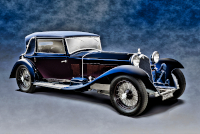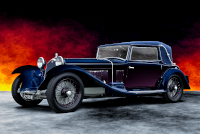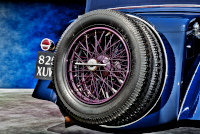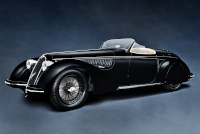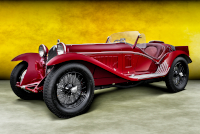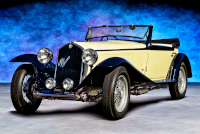Location:
ModaMiami, 2024
Owner: Christopher John Bentley, MBE | Harrogate, United Kingdom
Prologue:
Widely photographed after restoration in 2008, this 8C spent the following 15 years or so out of the public eye. Most images since stem from Gooding & Company auctions. In this respect, finding chassis #2311214 at Miami was a treat, though I feel the bright Florida sun did the car no justice. In a collection of classic era European sports cars, the crowd drifted toward brighter color and contrast, whereas the dark livery and straight lines of this Castagna-bodied 8C burned into shadow. But look at the detail and svelte proportions and we see an uncommonly elegant 8C Alfa.
I've tried to explain that elegance in picture, perhaps show what the daylight pounded into glaring submission. (And even my stock suffered for the effort.) As the first car I've profiled from this inaugural ModaMiami event, I'm happy to resurrect the color and pay some attention to the details and reflections. I would even suggest that this 8C Alfa was something of an overlooked treasure, what with so many Pebble Beach winners and grand gestures of Modernist coachwork in attendance. While an 8C 2300 Cabriolet Castagna does not resonate as might an 8C 2900, it is the latter's direct predecessor, the ultimate road car born from the dominating race chassis of the day. In this case, knowing what the car is counts for more than what the car looks like.
- - - - - - - - - -
► Image Source: Nikon D750 (24.3 MP)
References:
- Classic Car Club of America, New England Classic Quarterly, Fourth Quarter, 2009, "Alfa Romeo Restoration" by Garth Story. Posted online by Paul Russell, this piece includes noteworthy images of #2311214 prior to restoration.
- Paul Russell and Company: The restoration shop provides a brief profile and nice detail images of #2311214.
- Gooding & Company: The 2023 live auction site fir #2311214 provides ample text and images, though note the sold price shown here dates to 2009.
- UltimateCarPage: A profile of #2311214 from Pebble Beach in 2008, lucky enough to capture the beautifully finished motor as well, by Wouter Melissen, January 19, 2010.
- TravelingWithTools: Mechanic Greg Stasko illustrates the nuances of Vittorio Jano's 8C motor in a way we simply cannot do from the outside.
The Castagna-bodied 8C is a high luxury piece. Built from the same racing mechanicals as the 8C 2300 Mille Miglia, the wheelbase is longer to better accommodate passengers. Castagna and Figoni contributed roughly the same number of coachbuilt examples, (about 15 total), creating a limited series of open touring cars that are the direct predecessors of the 8C 2900B Touring Spider of 1938.
The formula is the same: Take a supercharged straight 8-cylinder drivetrain and cloak a long chassis in an elegant aluminum body, creating the ultimate road version of a top-end race car. In the years prior to the Type 57 Bugatti, these 8C Alfas are the lowest, most potent touring cars available in Europe.
For low-chassis cars of the early 1930s, the Invicta S-Type springs to mind, foreshadowing the Type 57 surbaissé. But the Invicta lacks the racing pedigree of either Alfa Romeo or Bugatti. And of course this is the time when Alfa Romeo supplants Bentley as the all-conquering sports car manufacturer, winning Le Mans for four years from 1931 to 1934. So an exclusive coachbuilt road car falls well within the purview of Alfa Romeo.
As Simon Moore notes, Castagna completed eight of these cars. Prospero Gianferrari, Alfa Romeo direttore generale (CEO) from 1928 to 1933, chose one for himself. This nugget arrives from a primer put together by Parkside Publications for Moore's addendum to his three previously published books on the 8C, "The 8C Story Continues," which includes a photo of Gianferrari with his Castagna-bodied 8C, chassis #2211064. And in this case, we see that the Alfa Romeo boss determined the 8C Castagna best fit to crown the marque.
Chassis #2311214 is a later third series car. Both Gooding and Paul Russell provide a thorough owner history, which is never my priority in searching for proper context, but what I find interesting about this 8C is its early arrival in the United States. Following a pair of wealthy Italian owners, Moore found that, "by June 1941, the 8C had arrived in the US in New Jersey under the ownership of Frederick MacHugh, a US Navy lieutenant." Bringing a rare Alfa out of Europe during wartime is a rare occurrence, and in this case the Alfa found good stewards who kept the car together. By the time of its restoration in 2005, the original mechanical parts remained intact, and Paul Russell and Company could refurbish the wood frame and aluminum coachwork.
Also a worthy anecdote, the referenced CCCA quarterly piece from 2009 includes photographs of the Alfa's condition prior to restoration, along with a period snapshot of one-time owner Haig Ksayian with #2311214. In this case I read the caption, "Photo courtesy of the Gordon Barrett Collection" with a smirk. Barrett completed his laborious restoration of 8C 2300 Corto MM Touring Spider #2211071 in the early 2000s, a project few knew about at the time, and one hardly anybody knew would yield such incredible results. But Barrett proved a dedicated historian of Alfa Romeo technical development and a fine enough engineer in his own right to turn back time and bring about a factory-new 8C 2300 MM.
This 8C Castagna emerged from restoration in Essex, Massachusetts a few years after Barrett finished his 8C, the Castagna's commission to Paul Russell issued by owners Bud and Thelma Lyon of Kensington, New Hampshire. The result in each case is tremendous; these are best-of-breed 8C Alfa cars presented in the finest order. And I realize that statement sounds hyperbolic, but we do look to Barrett's 8C 2300 MM Touring Spider as the peak example of an original sports-racing 8C, and we look to this 8C Castagna as the peak example of the period's luxury touring cars. Both are entirely original and finished to a superlative level. Both cars drew top class honors at Pebble Beach, for example. Just that, in historical perspective, one is the apogee of Alfa race philosophy and one is the ultimate extension of that philosophy put to grand touring purposes.
Motor: 2,336 cc straight 8-cylinder, alloy block, aluminum hemi-head | 65 mm x 88 mm | 6.6:1 compression | motor #2311214
Vittorio Jano's race-prepared 8C motor uses a magnesium crankcase with aluminum main caps. On the case sit two aluminum cylinder blocks with iron liners, topped by a separate cylinder head formed in two 4-cylinder sections.
Valvetrain: DOHC, 2 valves per cylinder, gear-driven via a central mechanism between each 4-cylinder block
The center of the crankshaft uses a sprung gear hub to control tolerance between both halves. Each camshaft is two pieces joined at the cam gear in the middle.
Aspiration: Memini twin-choke carburetor, Roots-type supercharger
Power: 152 bhp at 5,000 rpm
Gooding & Company write: "The engine rebuild was entrusted to Leydon Restorations, one of the foremost specialists in prewar Alfa Romeos. Following the rebuild, the engine was run on a dynamometer and developed 152 bhp and 178 lb-ft of torque—figures that exceed the factory claims."
Drivetrain: 4-speed gearbox, rear-wheel drive
Front Suspension: beam axle, semi-elliptic leaf springs, friction dampers
Rear Suspension: live axle, semi-elliptic leaf springs, friction dampers
Architecture: pressed steel chassis with aluminum coachwork by Castagna of Milan
Kerb Weight: 1,000 kg (2,204.6 lbs)
Wheelbase: 3,100 mm (122 inches)
Top Speed: 170 km/h (about 106 mph)
Etymology:
'8C 2300' refers to the motor configuration, a straight 8-cylinder of about 2.3 litres displacement. 'Cabriolet' is carriage-speak for a two-wheel open carriage of a sporting shape, which in the automotive lexicon bears reference to the folding top and similarly light use. 'Lungo' denotes the lengthy 3,100 mm wheelbase. The Milanese coachbuilder Castagna crafted the aluminum body.
Figures:
Various reports cite that Alfa Romeo built anywhere between 188 and 195 8C 2300 cars. The Alfa factory cites over 300 8C 2300 cars built from 1931 to 1934. Of these, Castagna bodied eight long-chassis 8C 2300 cars; fewer than that number survive.
Value:
Chassis #2311214 sold at Gooding & Company's 2023 Pebble Beach auctions for $4,515,000.
Previously, chassis #2311214 sold at Gooding & Company's 2009 Pebble Beach auctions for $4,180,000.
Original Again: Reconstructing the 8C 2300 Cabriolet Castagna
Chassis #2311214 underwent cosmetic modification through the 1930s and remained in modified condition until the 1950s when it first left the road. Paul Russell and Company write, "According to Gioacchino Acampora of Archivio Carrozzeria Castagna, the unusual styling features were a result of a succession of evolutionary styling updates made to the original coachwork by Castagna and shown by the coachbuilder in the Milan Salone dell'Auto. Our extensive research, in conjunction with noted Alfa Romeo authority Simon Moore, led us to the conclusion that there were essentially two different Castagna styling treatments within the eight LWB Castagna-built 8C 2300s, giving the Lyons the confidence to restore this car back to its 1933 configuration."
The most prominent modifications addressed the running gear, bonnet, and radiator shell. Castagna filled in the fenders, adding enough material in the front to cover most of the wheels down to the dumb irons, almost completing a valance but leaving the cowl between the frame rails as is. Along the flanks, the coachbuilder added slim skirts very much of the same style added to the 6C 1750 Gran Sport Cabriolet, #121215037; these are not full skirts but abbreviated, of a template intended to modernize the design in lieu of burgeoning trends. Unskirted fenders would have seemed antique even by the mid-1930s.
However, as in the case of the 6C 1750 Gran Sport, late restoration removed these additions. As Paul Russell state, "The fact that there had been changes and modifications made to the body was immediately evident," and period photos in the CCCA quarterly piece clearly show the boundaries between the original fender lines and added alloy.
On the bonnet sides, Castagna replaced the classic vertical bonnet louvres with a set of long horizontal louvres, a feature reminiscent of American streamlining circa 1935. That said, changing vertical louvres for horizontal lines seemed a popular customization of the day. Below the louvres sat a row of tilting rectangular vents. Gone too were the integrated tool boxes on the running boards. Instead, the chrome speedlines continued forward alongside the bonnet.
The radiator shell replaced the squared-off base with metalwork that gradually tapered to a crest. The grille curved down and out gently, very much in the style of a 1932 Packard shovelnose unit. Castagna also tapered the upper bouts of the shell, removing the radiator cap and meter in favor of a brow with a clean central crease rising up to meet the bonnet hinge.
Each of these modifications constitutes an attempt to modernize the design. Not content with classic—which is what Castagna does best—the coachbuilder used chassis #2311214 to test trends and demonstrate ideas that chased emerging streamlining concepts, if not aping American touring car style. The car as depicted today removes all of these modifications in favor of Castagna's original, classic design.
Figoni Comparison: The 8C 2300 Cabriolets from Castagna and Figoni
The more complex of the 8C Figoni cars wear French sweeps that taper from the bonnet center-line down along the flanks. Of course #2311207 shown elsewhere in this portfolio is rather straight in comparison. But in any case, either the Castagna or the Figoni design looks best with the hood up. Otherwise the passenger compartment runs the danger of resembling an apple cart from certain angles. These are not yet the high classic era designs of 1938, still primitive in artistic concept.
Castagna add a subtle curve along the lower edge of the hood, wrapping the rear compartment. Figoni leaves this edge straight, and as a result increases the gap between the rear fender crest and the shoulder line. In many cases, the hood fabric covers over the body, whereas Castagna accentuate the curves around the rear compartment. In lieu of a sweep panel flank, Castagna sculpt the door sills and binding. In this regard, their attention to detail and body shape keeps the overall form diminutive, whereas the back quarters of the Figoni car appear boxy.
That said, (and not to be too critical), the best of the Figoni cabriolet cars is probably chassis #2311239, which eases the bulk of the body with sweeping fenders and a gently curved tail. These elements complement the French sweep on the flank, drawing the design together.
Chassis #2311214 is simpler than #2311239, but of near-perfect proportion. Details such as the faired-in tool boxes fit harmoniously with the overall composition, echoed by the contoured shoulders of the boot lid. Also the one half-louvre in the set ahead of the door is clever, narrowing the gap between the taller louvres and reclined door seam. These are careful considerations, very carefully set in place. So comparison between Castagna and Figoni becomes a matter of gesture versus detail.
Of course color selection helps. Gooding & Company cite the livery on #2311214 as dark blue, claret, and workshop grey. The application of three classic colors to distinct linear components enunciates how well the pieces fit into place. In this case, the color selection may be recent, but the lines and shapes the colors dress are formally correct.
As with any design exercise, handmade results vary from one car to another. Survival and the need for restoration further cloud the coachbuilder's original intentions. What we then look for is a clear theme, a sense of the objective. In the case of #2311214, the pieces fit so well that no measurement of this long-chassis Alfa seems egregious. The Castagna design fits the platform using fine materials, rather the tailor's gold standard, to say nothing of ornament. Figoni often reversed this approach, selected a theme and then drew the components together around it.
To this end, calling out #2311239 in the context of discussing #2311214 demonstrates how both approaches can work. If we are to label the 8C 2300 Cabriolet as the predecessor of the 8C 2900B Touring Spider, it is these rare examples by Castagna and Figoni that prove the point.
Last Updated: Mar 26, 2025

